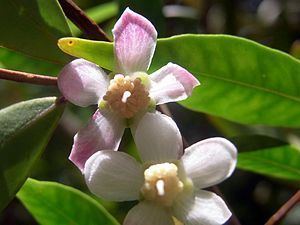Genus Uromyrtus Rank Species | ||
 | ||
Similar Uromyrtus lamingtonensis, Endiandra floydii, Gossia fragrantissima, Diospyros mabacea, Elaeocarpus williamsianus | ||
Uromyrtus australis, commonly known as the Peach Myrtle, is a small tree growing around Nightcap National Park, New South Wales, Australia. It is endangered by extinction. The delicate foliage, pink flowers and appealing fruit makes this a particularly beautiful tree.
Contents
Distribution and habitat
Restricted range associated with a very high rainfall and Coachwood on warm temperate rainforest at an altitude of 400 to 770 metres above sea level. There are around 800 plants in the wild.
Description
Uromyrtus australis reaches a height of 12 metres (39 feet) and a stem diameter of 15 cm (5.9 in). The bark is flaky or scaly, brown. Dead bark is thin. The trunk is cylindrical but often crooked. The leaves are opposite and entire, and measure 2.5 to 4.5 cm (0.98 to 1.77 in) long, tapering to a tip. Shiny above but dull beneath. Young leaf growth with white hairs, new leaves bright red. Oil dots obscure. Branchlets with white hairs, becoming smooth with age. The leaf stalks 2 to 3 mm long, silky hairs only on young leaves. Only the midrib is prominent on both surfaces, lateral veins obscure, raised above but sunken below. There is no intramarginal vein.
In November and December white flowers appear, turning deep pink. The fruit is black berry; globular in shape. 5 to 8 mm in diameter with one or two cells, with two seeds in each. Fruit is ripe from April to July. After removing the aril, germination begins after two months without much difficulty.
